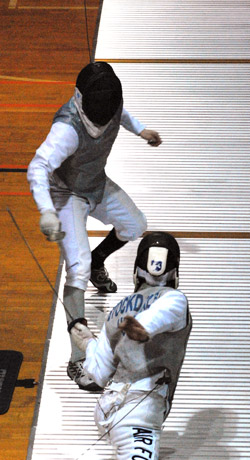Wasatch Fencing Abides by All SafeSport Practices, Procedures
 Wasatch Fencing abides by all SafeSport practices and procedures to assure all participants enjoy a safe and respectful sporting environment, free of abuse and harassment. All Wasatch Fencing coaches and volunteers undergo annual SafeSport training and background checks. The U.S. Center for SafeSport is an independent nonprofit committed to ending all forms of abuse in sport. This includes bullying, harassment, hazing, physical abuse, emotional abuse, and sexual misconduct and abuse. Wasatch Fencing abides by all SafeSport practices and procedures to assure all participants enjoy a safe and respectful sporting environment, free of abuse and harassment. All Wasatch Fencing coaches and volunteers undergo annual SafeSport training and background checks. The U.S. Center for SafeSport is an independent nonprofit committed to ending all forms of abuse in sport. This includes bullying, harassment, hazing, physical abuse, emotional abuse, and sexual misconduct and abuse.
Parents are an important part of the solution, as we all work together to prevent abuse in sport. Click here to access the SafeSport parent toolkit.
Additional Resources
FREE online parent training is available at www.athletesafety.org.
Injury Rate for Fencing is Very Low Compared to Other Main-stream Youth Sports
 Like all sports, there is no guarantee that a person fencing won’t be injured during training or competition. However, when compared to other main-steam sports, fencing is considered a very safe sport providing proper equipment is used within a safe environment supervised by knowledgeable personal. At Wasatch Fencing we insist that all equipment meets the highest safety standards and our personal is trained on maintaining a safe environment for our fencers. Like all sports, there is no guarantee that a person fencing won’t be injured during training or competition. However, when compared to other main-steam sports, fencing is considered a very safe sport providing proper equipment is used within a safe environment supervised by knowledgeable personal. At Wasatch Fencing we insist that all equipment meets the highest safety standards and our personal is trained on maintaining a safe environment for our fencers.
In a 2008 a 5-year study conducted by Peter A. Harmer, Ph.D., Chief Medical Officer of the Untied States Fencing Association it was found that time-loss injuries (injuries that require the fencer to withdraw from a competition) showed that the risk of significant injury was very low. Specifically, for youth 8-17 years old, the time-loss injury rate was 0.27 per 1,000 athlete-exposures (AE) (athlete-exposures is a metric used in sports epidemiology to compare injury rates across different sports). Another way to look at this number is that there was one (1) time-loss injury for approximately every 2,000 fencing matches that took place in these age groups. According to Harmer, it is also important to keep in mind that the study’s fencing data comes from national level competitions. The rate for teaching and practice situations is even lower.
Comparing the injury rate for fencing with other popular sports for high school-aged athletes, the combined rate for fencers Under-17 and Under-16 divisions was 0.34 per 1,000 AE. Results from the High School Sports-Related Injury Surveillance System for 2005-06 indicated the rate of a time-loss injury in high school soccer was 14 times greater than for fencing and 10 times greater in basketball. The high school sports with the lowest rates, boy’s baseball (1.77 per 1,000 AE) and girls’ softball (1.78 per 1,000 AE), were still 6.5 times higher than for fencing. In the matrix for establishing appropriate levels of medical care in intercollegiate athletics published by the National Athletic Trainers Association in 2000, fencing was tied with golf as the sport with the least risk of injury of the 22 sports examined.
It should also be noted that there have been no fatalities in the 100-year history of sport fencing in the USA and only four worldwide from 1995-2010 (competitions and practice). In comparison, research on fatal injuries in high school and college athletes in the USA shows that just in the decade from 1995-2005, 143 American football players, 63 basketball players and 20 soccer players died as a result of participation in their respective sports in the USA.
Finally, according to Harmer, the types of fencing injuries leading to time-loss were typical for sports with stop-start, rapid change of direction actions (i.e., sprains, strains, ruptures). Approximately 52% of all reportable injuries were strains and sprains (26.1% and 25.5%, respectively), followed by contusions (12%). Injuries specifically associated with the use of fencing equipment (puncture, laceration) and which generate the greatest concerns about the safety of the sport were very rare (only one (1) puncture occurred in a junior fencer (a small hand wound that did not require hospital care. This is among more than 25,000 young fencers competing in almost 100,000 matches.)
Learn more about Peter A. Harmer, Ph.D.
Even Though the Goal is to Hit your Opponent, the Fencing Injury Rate at Olympics, is Very Low
A study of injuries occurring in Olympic competition ranks fencing as having one of the lowest injury rates. Only 5 summer Olympic sports posted lower injury rates than fencing in this study of injuries from the 2008 Olympics. In terms of incidence in sports, soccer and taekwondo topped the list of summer sports, with an injury rate of over 30% for soccer. Fencing’s injury rate fell to the opposite end of the spectrum, at close to 2.5%

|